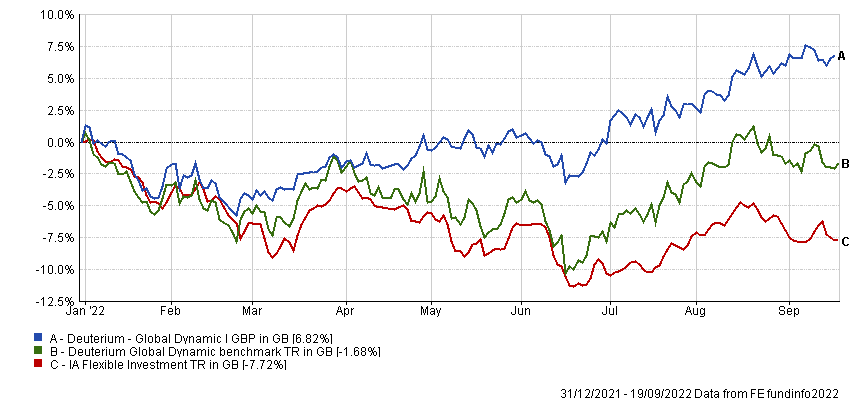Investors tempted back into markets in the hope of benefiting from the eventual recovery should beware it is unlikely to materialise until February at the earliest, according to Deuterium’s John Ricciardi.
Ricciardi manages the Deuterium Global Dynamic fund, which is based on a proprietary system that uses millions of data points to model economic forecasts. It then combines these forecasts with separate models for central bank policy, market valuations and price trends to predict the direction of asset classes.
The model guided the manager to cut the fund’s equity weighting to the minimum allowed (20%) early this year, reduce duration by as much as possible in the fixed income portion, and maximise exposure to the dollar. It also suggested he increase equity exposure ahead of the July rebound, then take profits before the market fell back again.
This has allowed the fund to make 6.8% in 2022, while its IA Flexible Investment sector average peer is down 7.7% and its benchmark – split 50/50 between the FTSE World Local index and Bloomberg Barclays US Aggregate Bond index – has lost 1.7%.
Performance of fund vs sector and index in 2022

Source: FE Analytics
Unfortunately for equity investors, Ricciardi’s model is telling him to steer clear of the asset class for the time being, in part due to one of the biggest slowdowns in retail sales since 2008.
“It's because disposable income has been trashed in the US – it’s down 8% in real terms for salaries since the current administration took power,” he explained.
“People are using credit cards to maintain their spending, which they won't be able to do for long. This is on the aggregate demand side, but it's also evident on the output side – if you look at factory orders, it’s the worst for 10 years.”
Ricciardi doesn’t expect much respite in the form of falling inflation, either. While his model suggested price increases will stabilise, they will do so around the current high single-digit figures.
He pointed out this is the predictable outcome of the stimulus that central banks pumped into the financial system in response to the coronavirus pandemic.
“What happens if you have a 20% growth in money supply but only 10% growth in real output is the excess money goes into prices between 18 and 24 months later,” he explained.
“With 20/20 hindsight, it probably would have been judicious for the US Federal Reserve to start raising interest rates last year, and now we have higher inflation than otherwise would have been the case.
“This inflation is likely to run until at least the coming quarter and probably the quarter after that as we head into a global recession.”
It is not all bad news, however. While Ricciardi’s model only makes forecasts for periods of up to four months, he said a year of “the tightest monetary policy you can imagine” is likely to push inflation significantly lower by the end of 2023.
And while he warned that the global economy will have entered a recession before this point, he said it is likely to be relatively mild.
“A lot of people are likely to panic when we head into this recession as the Fed has to keep rates up – there will be no pivot,” he continued.
“They may be under the impression that we have a structural bear market, rather than a cyclical one. The one in 2008 was a structural bear market and it wasn’t until 2015 or 2016 that we really began to recover.
“It doesn't look like that to us so far. Famous last words, but there you go. The fiscal and monetary authorities haven't broken it yet – but that doesn't mean they can't.”
Ricciardi added that, despite his warnings, it is inevitable that many investors who are already down will bow to pressure and reduce their risk exposure to protect against further losses – at exactly the wrong time.
“Eventually, they're all going to panic into long-term bonds, then they'll get killed because eventually there'll be a huge reaction,” he added.
“There will be things to buy. The minute the Fed pivots, the Yen's going to go from 145 to 100 to the dollar in two days. But that's not even a quarter away, it’s probably further out than that.”






